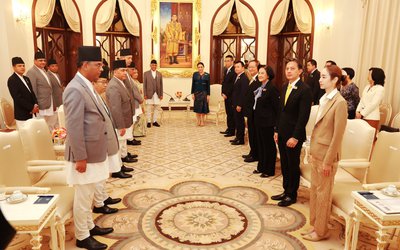More on News





On behalf of the Association of International NGOs in Nepal (AIN), we are pleased to share AIN Appeal for Nepal's Reconstruction. In view of the upcoming "International Conference on Nepal's Reconstruction: Towards a Resilient Nepal" being held on 25 June 2015, this Appeal presents AIN commitments and offers recommendations to the Government of Nepal and donor countries and organizations.
According to a press release, it aims to assist the Government of Nepal, by providing inputs on behalf of the AIN member INGOs, in creating a comprehensive and inclusive post disaster reconstruction plans and implementation strategies.
AIN highly acknowledges the effective role played by the Government of Nepal for earthquake response and relief work. We are equally appreciative of the support provided by the International Communities, Bilateral and Multilateral Donors, Private Organizations, Civil Society organizations, INGOs and NGOs.
AIN seeks to go hand in hand and complement the government efforts of reaching out to the most vulnerable earthquake affected populations based on the needs assessments and in accordance with humanitarian principles.
The earthquake of 25 April 2015 and subsequent aftershocks have had a devastating impact on Nepal. More than 8,700 people have been killed and 22,000 injured, almost 800,000 houses have been fully or partially damaged, and nearly three million people need humanitarian assistance. Health posts, police posts, and other local government service delivery infrastructures have been damaged, as well as more than 45,000 classrooms, affecting the state's ability to deliver education, health and other primary services. Similarly, public property, infrastructure and historical and cultural heritage have suffered huge losses. To address Nepal's enormous challenge of reconstruction, the Government of Nepal is organizing on 25th June 2015 the “International Conference on Nepal’s Reconstruction: Towards a Resilient Nepal”.
The conference aims to bring together representatives of partner governments, multilateral organizations, private sector and civil society to discuss Nepal’s reconstruction needs and secure funding commitments for a reconstruction plan. Established in 1996, the Association of International NGOs (AIN) is a network of 116 INGOs working in Nepal on a wide-range of issues and sectors to support the country’s development efforts. INGOs and their partners have contributed to bring transformative change in people's lives in many sectors including education, health, water and sanitation, environment, disaster management and livelihoods.
AIN APPEAL says AIN Chair, AIN members and partners will continue to be important actors in the reconstruction process. On the occasion of the “Towards a Resilient Nepal” conference, the AIN presents these commitments and recommendations to the Government of Nepal and donors countries and organizations.
The AIN acknowledges the government’s response to the earthquake. The government: • Immediately activated clusters and coordination mechanisms; ensured Chief District Officers and District Disaster Relief Committees (DDRC) were active in coordinating the rescue and relief operations. • Mobilized security forces for search and rescue operations, relief delivery, opening of roads, and maintenance of law and order; identified sites to host people; activated emergency services in hospitals, and used Radio Nepal to disseminate timely live-saving information. • Organized short- term easing of custom clearance, tax exemption, visas and other administrative requirements. • Led a Post-Disaster Needs Assessment (PDNA) and planned for the international donors’ conference to start discussing postdisaster reconstruction plans and strategies.
The variety of sectors included in the PDNA reflect the multiplicity of needs and sectors involved in Nepal's reconstruction. • Put in place policies to enhance the protection of vulnerable populations, including directives to protect children against trafficking. AIN members and partners in Nepal: • Supported, prior to the earthquake, community-based disaster risk management; built the capacity of key stakeholders in relation to earthquake preparedness and response, including by retrofitting hospitals and schools, stock piling relief materials and strengthening water storage; and integrated disaster risks management considerations in our development initiatives. • Are working with local authorities and local partner organisations in all 14 districts severely affected by the earthquake to provide relief support including temporary shelters, food and non-food items, medicine and medical services, water, sanitation and hygiene kits, temporary learning centres, child and female friendly spaces , and psycho-social counselling to complement the government’s relief efforts. We are also working closely with the government and the Centre Child Welfare Board to monitor women and children at risk of trafficking.
This assistance is provided in close coordination with DDRCs and clusters led by government authorities in all affected districts to ensure accountability, transparency and compliance with government notifications and regulations. • Are working to provide assistance and protection to the most vulnerable among the earthquake affected populations (including minorities, women, children, the elderly and people with disabilities) based on needs assessments, in accordance with humanitarian principles.
AIN suggests that the Government of Nepal: • Develops a comprehensive reconstruction strategy that is nationally led and fosters partnership and coordination amongst government authorities, private sector, civil society, donor communities, I/NGOs and development partners.
The strategy should define and facilitate INGOs’ role in aid delivery, reconstruction and long-term development. This includes ensuring the use of the regular Social Welfare Council (SWC) mechanism, easing and fast tracking the process of project registration and developing a standard set of guidelines and instructions for INGOs operations in order to facilitate compliance, accountability, coordination and uniformity. • Ensures community participation (including of women, children and marginalized communities) in relief, recovery and reconstruction efforts through inclusive, transparent and accountable processes.
People’s rights and the specific needs of children, women and socially marginalized groups should be fully addressed and met in recovery and reconstruction plans. • Considers extending the first phase of relief to three months at minimum to ensure that life - saving aid, including all forms of shelter materials, can be delivered to needy communities in a speedy and cost efficient manner before the monsoon starts. • Ensures that the reconstruction efforts promote sustainable livelihoods and stronger service delivery mechanisms including in health and education in both affected districts and the rest of Nepal. • Conducts professional geological and socioeconomic assessments to establish whether the current locations of communities are safe.
If unsafe or unfit, temporary and longer-term relocation should be considered with community participation and in accordance with international principles including voluntariness. • Establish strong coordination between intergovernment agencies and clusters to enable collaboration to meet sector targets, with a focus on gender mainstreaming and protection concerns relating to children, the elderly, people with disabilities as well as marginalised groups. • Reduce communities’ vulnerabilities to disaster risks through adopting the National Disaster Management Act to provide a comprehensive legal framework and institutional mechanism to manage disasters, mainstreaming disaster risks reduction in development plans and finalising the national safe school policy. • Ensure that protection measures are integrated into reconstruction plans to reduce risks of violence, abuse and exploitation.
This includes ensuring that children in earthquake affected areas can resume their education as soon as is possible and establish mechanisms to monitor and track girls and boys who are returning to school, have dropped out, or are at risk of dropping out.
AIN suggests that donor countries and organizations: • Support national and local government institutions to lead and manage the recovery and reconstruction processes, including on the implementation of the above recommendations. • Provide long-term funding for reconstruction and disaster risk reduction based on a review of investments to date, and encourage and adequately support reconstruction efforts that reduce underlying vulnerabilities to disaster risks. • Ensure that the aid provided is in line with humanitarian principles and is transparent, needs based, accountable, culturally sensitive. • Support the government in developing detailed recovery and reconstruction assessments and strategies in consultation with affected communities and other key stakeholders, to ensure plans are responsive to local needs and priorities. • Support the integration of protection, including child protection, in reconstruction efforts to reduce risks of violence, abuse and exploitation. This includes giving greater priority to education and recognize its contribution to reducing risks to violence, abuse and exploitation • Work with the government to create an enabling working environment for INGOs as key partners in the recovery and reconstruction process. AIN, on behalf of its INGO members, commits to: • Support the government’s efforts and plans in the reconstruction of earthquake-affected areas and in ensuring better preparedness for future disasters across the whole country • Ensure coordination at both national and local levels between all stakeholders for a coordinated and effective recovery and reconstruction process. • Be transparent and accountable for the allocation and spending of their resources in the recovery and reconstruction work. • Continue to work in close consultation with the government in linking emergency response to long-term development work by building capacity of local authorities, and sharing international best practices. • Consult communities to identify and prioritise the most vulnerable, with a view to providing needs based assistance, in line with humanitarian principles, in all the recovery and reconstruction processes. • Continue to establish feedback mechanisms to strengthen accountability to affected communities, and to improve our response to improve our ability to meet the specific needs of communities.





